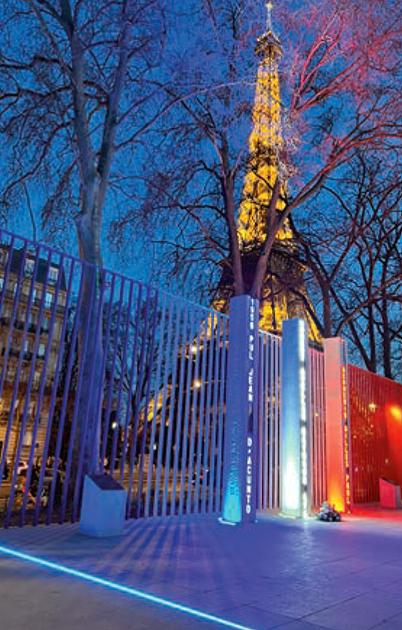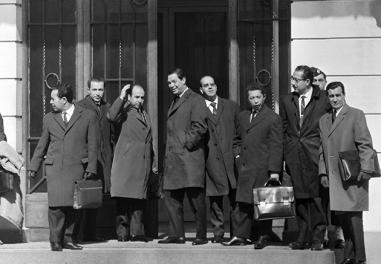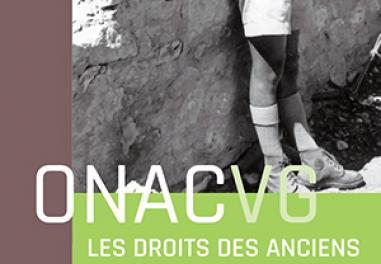Remembering the Algerian War
The Memorial to the Algerian War and the fighting in Morocco and Tunisia is a Major National Remembrance Site of the Ministry of the Armed Forces. The man behind it, Gérard Collin-Thiébaut, and the staff of the National Office for Veterans and Victims of War (ONAC-VG) talk about the meaning and utility of the work.

Can you describe the memorial to us?
Gérard Collin-Thiébaut (GCT): The site overlooking the Seine that was chosen for the Memorial to the Algerian War and the fighting in Morocco and Tunisia recalls the quayside from which French service personnel set sail for Algiers. The memorial consists of a line of three pillars, each two metres apart, with an obstacle-free open space before them, which passers-by can walk across. On the front of each pillar is an LED display. The first, in blue, and third, in red, present a rolling list of names of the approximately 26 000 French servicemen and civilians who were killed in the conflicts, in alphabetical order and by year. The middle pillar, in white, displays nearly 1 700 names of civilian victims, including 1 597 disappeared and 49 victims of the Rue d’Isly massacre, together with the names of the 101 people who were abducted and whose bodies were buried. The alignment of the pillars and the fence in the background permanently evoke the tricolour flag.
Two totems presenting a summary of the history and symbolism of the monument are also found on site. They are equipped with touchscreens connected to the red pillar, enabling a name search and offering access to historical, academic and image content.
What outreach activities do you carry out in connection with the memorial?
ONAC-VG: As with the other three Major National Remembrance Sites in Île-de-France [the Paris area], the Office’s purpose here is to pay tribute, with an overwhelmingly educational focus. For the memorial, this means receiving groups on site – school parties, Universal National Service volunteers, individuals and members of remembrance, veteran or patriotic organisations – and also university groups, whose subject of study is the development of remembrance of the history of contemporary conflicts, from the Second World War to overseas operations.
Meanwhile, we are developing a cultural events programme, which began during the European Heritage Days in 2020 with a dramatic reading of the writings of Germaine Tillion on Algeria, produced in partnership with Théâtre de l’Imprévu.
We have an ambitious programme in place for this important commemorative year, which aims to evoke the plurality of memories of the war, in close connection with ONAC-VG’s “History and remembrance of the Algerian War” programme: talks, plays in collaboration with the Théâtre du Gymnase Marie Bell (22 June 2020, booking required), etc.
Renovation of the memorial has just been completed. What was its goal?
ONAC-VG: On the initiative of the Minister for Remembrance and Veterans, a working group, co-run by the Directorate for Heritage, Remembrance and Archives and ONAC-VG, was set up in 2017 to look at enhancing the memorial and the memories it evokes. It presented its proposals in 2019, suggesting the expansion of the site to make it sacrosanct and clearly display its purpose.
Today, the Memorial of the Algerian War and the fighting in Morocco and Tunisia is a key site that offers direct access to historical, academic and remembrance content on site. It is a tribute to the dead and an effective outreach resource.
GCT: The renovation project affirmed, once and for all, the memory of those who gave their lives in the Algerian War and the fighting in Morocco and Tunisia, and disseminates it with pride. This new version preserves the work’s essence, harmony and proportions, but the presence of a new perimeter on the ground and a fence behind affirm the need for such a monument in a moderate, sober and balanced way. The result is a new gravity, condensing 60 years of reflection on these conflicts.
Articles of the review
-
The file

1962: the end of the war in Algeria
On 18 March 1962, in Évian-les-Bains, the French Government and its Algerian counterparts signed an agreement that paved the way for Algerian independence, heralding the end of 132 years of colonisation and a war that had begun in 1954. It did not lead to the immediate cessation of violence and clas...Read more -
The event

Algeria in the ECPAD archives
Read more -
The figure

The National Office for Veterans and Victims of War
The National Office for Veterans and Victims of War (ONAC-VG) is an executive agency of the Ministry of the Armed Forces that guarantees the nation’s recognition of those who have served it. Today it is the “one-stop shop” for harkis and their families, who it supports in their applications. ...Read more

